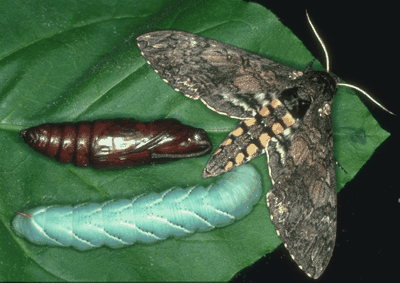
Manduca sexta(Manduca sexta)
Phylum —arthropoda
Class —insecta
Order —lepidoptera
Family —sphingidae
Genus –manduca
Appearance
Abdomen usually has 6 pairs of yellow bands. Forewing has indistinct black, brown, and white markings. Hindwing is banded with black and white and has 2 black zigzag median lines that are very close together with hardly any white showing between them. Wing fringes on forewing are spotted with white.
Wing Span: 3 3/4 - 4 3/4 inches (9.5 - 12 cm).
The larvae of these species can be distinguished by their lateral markings: Manduca sexta have seven white diagonal lines with a black border. Additionally, Manduca sexta have red horns.
Habitat
Manduca sexta has a large distribution throughout the New World, occurring as far south as Chile. In the United States it occurs from coast to coast. It is found as far north as Nebraska in the Great Plains and Massachusetts on the East Coast.
Behavior
Adults are active and fly at dusk. Butterflies and caterpillars are poisonous.
It overwinters in the pupal phase.
Diet
In nature, Manduca sexta larvae feed on plants in the family Solanaceae. After emergence, adults feed on the nectar from flowers. It can bea pest of tobacco and tomato.
Reproduction
Females lay eggs on the leaves of host plants. Manduca sexta eggs are spherical, approximately 1.5 millimeters in diameter, and translucent green. They typically hatch two to four days after they are laid. Eggs are normally found on the underside of foliage, but can also be found on the upper surface.
In captivity
The mesh cage with a size of 50 × 50 × 70 mm is suitable for keeping butterflies. Room temperature is necessary. Daylight time is 12 hours. You can feed butterflies with honey syrup diluted with boiled water in a ratio of 1:10.It is better to pour the syrup into a white container and put it on a raised platform.
For their reproduction you need a terrarium with a size of 50x50x70 cm. Females lay eggs one at a time on the leaves of the forage plant.In the terrarium, you need to place a branch of a forage plant. Also, the caterpillars can be fed with synthetic feed, which is made from agar-agar, casein, sucrose and wheat germ with the addition of vitamins. Room temperature,daylight time is 14-17 hours. The humidity is 40-60%.
The caterpillar develops for 2-3 weeks. Older caterpillars should be placed on the bottom of the wet substrate with a layer of 8-10 cm, because the process of becoming a pupa takes place underground. The pupal stage lasts 2-3 weeks. If it is necessary, the pupae can be placed in the refrigerator immediately after pupation, this will delay the hatching of the butterflies.
Manduca sexta has a short life cycle, lasting about 30 to 50 days.
 Russian
Russian
 English
English























